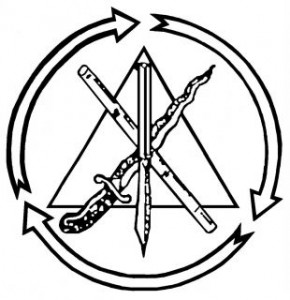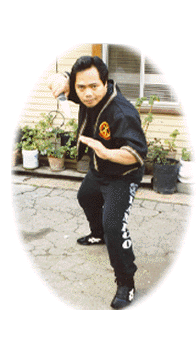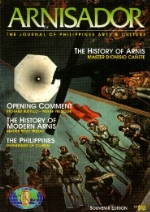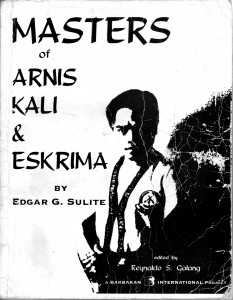
Lameco Eskrima is a Warrior Art of the Philippines founded by the late Punong Guro Edgar Sulite . It was based on his training and experience with various Master Eskrimadors. The most heavy influence was from Grandmaster Jose Caballero and Grandmaster Antonio Ilustrisimo. In private Punong Guro Sulite that in a real fight, these these two systems were the only arts he drew upon. This fact was the foundation for his Lameco Backyard Group training method that included sparring at different intensity levels on a regular basis.
The Philippines is an archipelago of over 7,100 different islands broken up into three main regions: Luzon, Visayas and Mindanao. Within each of those regions lies numerous styles of the Philippine Fighting Arts. There are some systems which specialize in long range fighting (LARGO), while others specialize in medium range fighting (MEDIO), and still others which specialize in close range fighting (CORTO).
An acronym for the synthesis of the three ranges of combat (LARGO, MEDIO and CORTO) were combined to form LAMECO.
| Acronym | Range | Measurement |
|---|---|---|
| LA | Largo (Long Range) | Dulo to Dulo (Tip to Tip) |
| ME | Medio (Medium Range) | Pulso to Pulso (Wrist to Wrist) |
| CO | Corto (Close Range) | Balikat to Balikat (Shoulder to Shoulder) |
LAMECO is a composition of five major systems and six minor systems from the Philippines.
1) Kali Illustrisimo (Antonio “Tatang” Illustrisimo)
2) De Campo uno-dos-tres Orehinal (Jose D. Caballero)
3) Kali Pekiti-Tirsia (Leo T. Gaje Jr.)
4) Modernos Largo (Jesus Abella / Pablicito Cabahug)
5) Sulite Rapelon (Helacrio Sulite Sr.)
LAMECO is a balanced synthesis of the many effective teachings and styles which the late Punong Guro Edgar G. Sulite has come to master in the span of his life.
LAMECO has emphasis on the totality of the human being – mind, body, spirit – not just the physical elements alone.
ATTENTION, INTENTION, VISUALIZATION and COMPLETE FOCUS are the integral components of the LAMECO Training System.
The LAMECO logo represents the following items.
| Symbol | Representation |
|---|---|
| Arrows | The Flow of Nature. |
| Balisong Knife | Luzon – Northern Philippines. |
| Eskrima Stick | Visayas – Central Philippines. |
| Kris Sword | Mindanao – Southern Philippines. |
| Triangle | The Integration of Mind, Body and Spirit. |
Lameco Eskrima Training
One of the characteristics of Filipino martial arts is the use of weapons from the very beginning of training. The common weapon is a rattan stick, also called a cane or baston. These sticks vary in length from about 26 inches to as much as 38 inches in length or more. The weapons can vary in weight and thickness depending on the preference of the practitioner. However the Single Sword is the soul of this Warrior Art. Even when using a Rattan stick, members of Punong Guro Sulites Backyard Group were always told to treat the stick as a sword.
Lameco uses Double and single Stick, Double and single Dagger, Sword and Dagger, Sword, Staff, Handkerchief, and Empty Hands. Lameco Eskrima is a synthesis of five major and six minor systems of Eskrima.
Lameco employs training drills called Laban Laro (Play Fighting). Laban Laro allows the escrimador to come as close to real combat as possible without injury. It is also designed to get an uncountable number of repetitions in a short period of time.
Through his constant efforts for developing new training innovations, Edgar devised unique armor for the hands and forearms that allowed practitioners to safely train more realistically.
History
At a young age Edgar Sulite’s father exposed him to the Filipino Martial Arts, himself being a boxer and Arnisador. Growing up in the Barrios of the Philippines, Edgar witnessed many skirmishes settled blade against blade.
Five Major Influences on the Lameco Eskrima System:
1. De Campo 1-2-3 Orehenal (GM Jose D. Caballero)
2. Kalis Ilustrisimo (GM Antonio “Tatang” Ilustrisimo)
3. Pekiti-Tirsia Kali (Tuhon Leo Tortal Gaje Jr.)
4. Modernos Largos (GM Jesus Abella & GM Pablicito “Pabling” Cabahug)
5. Sulite-Rapelon (GM Helacrio L. Sulite Sr.).
Six Minor Influences on the Lameco Eskrima System:
1. Doce Pares (GM Diony Cañete)
2. Balintawak (GM Johnny Chiuten)
3. Lapunti Arnis De Abanico (GM Felimon E. Caburnay)
4. Siete Teros Serado – Serado no Puede Entrar (GM Marcilino Ancheta)
5. Abanico De Sungkiti (GM Billy Baaclo)
6. Tres Personas Eskrima De Combate (GM Maj. Timoteo E. Maranga).



